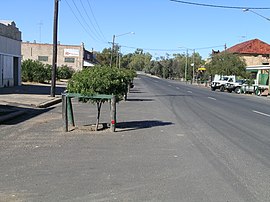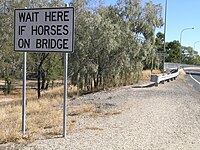Collarenebri (/kɒlərɛnəbraɪ/ COLL-ə-REN-ə-bry) is a town in north western New South Wales, Australia. The town is in the Walgett Shire Local Government Area and is situated on the Barwon River approximately 75 kilometres (47 mi) northeast of Walgett and south west of Mungindi on the Gwydir Highway. It is 16 km (9.9 mi) from Pokataroo which was the nearest railway town prior to closure of the rail service there. The town is 146 metres (479 ft) above sea level. Collarenebri is one of three towns ending in 'BRI' in Northern New South Wales.
| Collarenebri New South Wales | |
|---|---|
 Main street in 2008 | |
| Coordinates | 29°33′0″S 148°35′0″E / 29.55000°S 148.58333°E |
| Population | 650 (2016 census)[1] |
| Postcode(s) | 2833 |
| Elevation | 146 m (479 ft) |
| Location | |
| LGA(s) | Walgett Shire |
| State electorate(s) | Barwon |
| Federal division(s) | Parkes |

In the 2021 census, Collarenebri had a population of 638.[2]
Collarenebri is an indigenous word of the Gamilaraay galariinbaraay, meaning 'place of flowers' or 'eucalyptus blossoms'.[3][4] Collarenebri is well known for its flowers
History
editYuwaalaraay (also known as Yuwalyai, Euahlayi, Yuwaaliyaay, Gamilaraay, Kamilaroi, Yuwaaliyaayi) is an Australian Aboriginal language spoken on Yuwaalaraay country. The Yuwaalaraay language region includes the landscape within the local government boundaries of the Shire of Balonne, including the town of Dirranbandi as well as the border town of Hebel extending to Walgett and Collarenebri in New South Wales.[5]
Yuwaalayaay (also known as Yuwalyai, Euahlayi, Yuwaaliyaay, Gamilaraay, Kamilaroi, Yuwaaliyaayi) is an Australian Aboriginal language spoken on Yuwaalayaay country. It is closely related to the Gamilaraay and Yuwaalaraay languages. The Yuwaalayaay language region includes the landscape within the local government boundaries of the Shire of Balonne, including the town of Dirranbandi as well as the border town of Goodooga extending to Walgett and the Narran Lakes in New South Wales.[6]
Originally spelt "Collarindabri", Collarenebri is located near a shallow rocky ford on the Barwon River, which provided a hard bottomed shallow river crossing for stock and pioneering travellers.
The Gamilaroi Nation of Indigenous Australians resided in this region prior to white settlement.
In 1860 William Earl settled near the Collarenebri crossing and established "The Squatters Arms" to capitalise on the increasing traffic through the area. Earl and his pub later became famous for having been held up by bushranger Captain Thunderbolt. Earl is credited with having established present day Collarenebri, with a prominent street and aged housing carrying his name. A number of his descendants still reside in the town.[7]: 2
By the end of 1865, Collarenebri is described as having "two stores, a public house, with another nearly finished: the timber is also lying at Collarenebri for a Government punt; several small houses and a population of about 50 people stationary."[7]: 3
The town of Collarenebri was later gazetted on 12 July 1867. By 1890 Collarenebri had become a growing town with a hospital, police station, school and a number of businesses. The cemetery at Collarenebri dates back to 1906.
Collarenebri has long been recorded as a significant site for Aboriginal people living in the area. There are many artifacts and significant sites along the Barwon River. On Collymongle Station there are some very old aboriginal carved trees. There is a well maintained Aboriginal cemetery just outside the town which is unique to the area, with graves covered in crushed and melted glass and decorated with items that represent that person. Collarenebri continues to be a significant community for Aboriginal people.
Many of the buildings in Collarenebri today date back to c. 1910. Collarenebri was among the last places in Australia to be converted from a manual switchboard to an automatic telephone exchange (in 1986). Volunteers run Collarenebri's live, local radio station YAAMA-FM 95.9 specialising in indigenous programming.
Industries in the area include cotton and wheat farming, sheep and beef cattle breeding. Other activities include fossicking for gemstones such as topaz, agate and petrified wood.
The Barwon River area is regarded as one of the best inland fishing locations in Australia.
Sport
editCollarenebri has a rugby league team, the Collarenebri Bulldogs, who compete in the Barwon Darling Rugby League competition.
Heritage listings
editCollarenebri has a number of heritage-listed sites, including:
- Gundabloui Road: Collarenebri Aboriginal Cemetery[8]
Population
edit| Year | Pop. | ±% |
|---|---|---|
| 1966 | 581 | — |
| 1971 | 608 | +4.6% |
| 1976 | 599 | −1.5% |
| 1981 | 602 | +0.5% |
| 1986 | 623 | +3.5% |
| 1991 | 617 | −1.0% |
| 1996 | 544 | −11.8% |
| 2001 | 495 | −9.0% |
| 2006 | 478 | −3.4% |
| 2011 | 386 | −19.2% |
| 2016 | 435 | +12.7% |
| 2021 | 425 | −2.3% |
| Source: Australian Bureau of Statistics data.[9][10] | ||
In the 2016 Census, there were 650 people in Collarenebri.
- Aboriginal and Torres Strait Islander people made up 42.1% of the population.
- 90.4% of people were born in Australia and 89.9% of people spoke only English at home.
- The most common responses for religion were Anglican 31.1%, No Religion 26.3% and Catholic 17.3%.[1]
References
edit- ^ a b Australian Bureau of Statistics (27 June 2017). "Collarenebri". 2016 Census QuickStats. Retrieved 1 November 2018.
- ^ "2021 Collarenebri, Census All persons QuickStats | Australian Bureau of Statistics". abs.gov.au. Retrieved 21 August 2024.
- ^ History of the Collarenebri Region/Collarenebri Central School: "Collarenebri Central School". Archived from the original on 18 July 2008. Retrieved 2 June 2008.
- ^ "Collarenebri". Geographical Names Register (GNR) of NSW. Geographical Names Board of New South Wales. Retrieved 12 July 2009.
- ^ This Wikipedia article incorporates CC BY 4.0 licensed text from: "Yuwaalaraay". Queensland Aboriginal and Torres Strait Islander languages map. State Library of Queensland. Retrieved 23 January 2020.
- ^ This Wikipedia article incorporates CC BY 4.0 licensed text from: "Yuwaalayaay". Queensland Aboriginal and Torres Strait Islander languages map. State Library of Queensland. Retrieved 23 January 2020.
- ^ a b Newman, Charles (May 1985). Collarindabri 1861–1886. The Years of Struggle.
- ^ "Collarenebri Aboriginal Cemetery". New South Wales State Heritage Register. Department of Planning & Environment. H01934. Retrieved 18 May 2018. Text is licensed by State of New South Wales (Department of Planning and Environment) under CC BY 4.0 licence.
- ^ "Statistics by Catalogue Number". Australian Bureau of Statistics. Retrieved 19 January 2024.
- ^ "Search Census data". Australian Bureau of Statistics. Retrieved 19 January 2024.
Further reading
edit- Brown, Robert (1989). Plains of Colour. Carina, QLD: Walgett Shire Council.
External links
editMedia related to Collarenebri, New South Wales at Wikimedia Commons
- Collarenebri – Walgett Shire Council
Collarenebri travel guide from Wikivoyage
